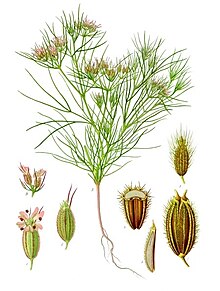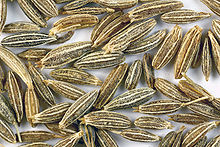জীৰা
| জীৰা | |
|---|---|

| |
| বৈজ্ঞানিক শ্ৰেণীবিভাজন | |
| Unrecognized taxon (ঠিক কৰক): | Cuminum |
| প্ৰজাতি: | C. cyminum |
| দ্বৈৰাশিক নামকৰণ | |
| Cuminum cyminum L.[1] | |
জীৰা (বৈজ্ঞানিক নাম: Cuminum cyminum) এবিধ বাৰ্ষিক তৃণজাতীয় উদ্ভিদ আৰু তাৰ বীজ। ঘাইকৈ মছলা হিচাপে ব্যৱহৃত জীৰা এছিয়াৰ স্থানীয় উদ্ভিদ।[2] ইয়াৰ ফলৰ ভিতৰত থকা জীৰাৰ গুটিসমূহ গোটাই বা গুৰি দুই ধৰণে খাদ্যত ব্যৱহাৰ কৰা হয়। ইয়াৰ ঔষধি গুণ আছে বাবে পাৰম্পৰিক চিকিৎসা পদ্ধতিত জীৰা ব্যৱহাৰ কৰা হয়।[3] ভাৰত, চীন আৰু মেক্সিকোত জীৰা খেতি কৰা হয়। ই ভাৰতীয় খাদ্যশৈলীৰ অন্যতম অপৰিহাৰ্য মছলা।
নাম
[সম্পাদনা কৰক]অসমীয়া নাম 'জীৰা' সংস্কৃত ভাষাৰ 'जीरक'ৰ (জীৰক) পৰা আহিছে। ইয়াৰ অৰ্থ হৈছে খাদ্য পাচক। আয়ুৰ্বেদত জীৰাক পাচনৰ সহায়ক বুলি গণ্য কৰা হয়।
বিৱৰণ
[সম্পাদনা কৰক]জীৰা এবিধ তৃণজাতীয় উদ্ভিদ। ই প্ৰায় ৩০-৫০ ছেণ্টিমিটাৰ ওখ হয় আৰু সচৰাচৰ হাতেৰে গুটি চপোৱা হয়। ইয়াৰ গা-গছ কোমল আৰু প্ৰায় ২০-৩০ ছেণ্টিমিটাৰ মান হয়।[4] প্ৰতিটো ডালত দুই বা তিনিটা উপ শাখা থাকে। গোটেই শাখা-প্ৰশাখা বোৰ সমান উচ্চতালৈ বৃদ্ধি পায়।[4] ইয়াৰ কাণ্ডৰ ৰং ডাঠ সেউজীয়াৰ পৰা ধোঁৱা বৰণীয়া। ইয়াৰ পাতসমূহ ৫-১০ ছেণ্টিমিটাৰ দীঘল হয়। পাতৰ আকাৰ সূতাৰ দৰে। কিছুমান পাত দুটা ভাগত বিভক্ত। ফুলসমূহ সৰু আৰু বগা বা গুলপীয়া ৰঙৰ। পুষ্পবিন্যাস ছাতি সদৃশ।[4] ফল সমূহ উপবৃত্তাকাৰ আৰু ভিতৰত এটা গুটি থাকে।[4] জীৰা গুটিত আঠটা সিৰা থাকে।[4] জীৰা গুটি দেখিবলৈ চঁফ গুটিৰ দৰে। গুটি সমূহ ৰ'দত শুকুৱাই গোটাকৈ বা গুৰি কৰি মছলা হিচাপে ব্যৱহাৰ কৰা হয়।
ইতিহাস
[সম্পাদনা কৰক]
পূব ভূমধ্যসাগৰীয় অঞ্চলৰ লেভেণ্ট অঞ্চলত জীৰাৰ উৎপত্তি হৈছিল।[5] হাজাৰ বছৰৰ আগৰ পৰা জীৰা মছলা হিচাপে ব্যৱহাৰ হৈ আহিছে।[6] চিৰিয়াৰ তেল-এড-ডেৰত খননত খ্ৰীষ্টপূৰ্ব ২০০০ বছৰৰ পুৰণি জীৰাৰ অৱশেষ উদ্ধাৰ কৰা হৈছে। ইজিপ্তৰ বহু পুৰাতাত্বিক স্থলৰ খননত জীৰাৰ অৱশেষ পোৱা গৈছে।[5][7] প্ৰাচীন ইজিপ্ত সভ্যতাত জীraক মামী বনোৱাত ব্যৱহাৰ কৰা হৈছিল।[5][4] প্ৰাচীন ক্ৰেটেৰ মিনোৱান সভ্যতাতো জীৰা মছলা হিচাপে ব্যৱহাৰ কৰা হৈছিল।[8] প্ৰাচীন গ্ৰীচত খোৱামেজত জীৰাৰ পাত্ৰ এটা ৰখা নিয়ম আছিল আৰু এই নিয়ম মৰক্কত এতিয়াও পালন কৰা হয়। ৰোমান সকলেও মছলা হিচাপে জীৰা ব্যৱহাৰ কৰিছিল। ভাৰতত হাজাৰ বছৰৰ পৰা অসংখ্য খাদ্যত জীৰা ব্যৱহৃত হৈ আহিছে।
স্পেনিছ আৰু পৰ্তুগীজ কলনীয়ে আমেৰিকালৈ জীৰা নিছিল। বৰ্তমান ভাৰতীয় উপমহাদেশ, উত্তৰ আফ্ৰিকা, মেক্সিকো, চিলি আৰু চীন দেশত ঘাইকৈ জীৰাৰ উৎপাদন কৰা হয়।[6][9]

কৃষি আৰু উৎপাদন
[সম্পাদনা কৰক]তথ্য উৎস
[সম্পাদনা কৰক]- ↑ USDA, ARS, Germplasm Resources Information Network. জীৰা in the Germplasm Resources Information Network (GRIN), U.S. Department of Agriculture Agricultural Research Service. Accessed on 13 March 2008.
- ↑ Boning, Charles R. (2010). Florida's Best Herbs and Spices: Native and Exotic Plants grown for Scent and Flavor (1st সম্পাদনা). প্ৰকাশক Sarasota, Fla.: Pineapple Press. পৃষ্ঠা. 79. ISBN 978-1-56164-453-7. https://books.google.com/books?id=uTIoxgzULJcC&pg=PA2&lpg=PA2&dq=isbn+978-1-56164-453-7&q=cumin.
- ↑ "Cumin". Drugs.com. 2018. https://www.drugs.com/npp/cumin.html। আহৰণ কৰা হৈছে: 24 February 2018.
- ↑ 4.0 4.1 4.2 4.3 4.4 4.5 Sastry, E. V. Divakara; Anandaraj, Muthuswamy. "Cumin, Fennel and Fenugreek". Soils, Plant Growth and Crop Production. Encyclopedia of Life Support Systems (EOLSS). http://www.eolss.net/sample-chapters/c10/e1-05a-50-00.pdf। আহৰণ কৰা হৈছে: 29 November 2013.
- ↑ 5.0 5.1 5.2 Nabhan, Gary Paul (2014). My library My History Books on Google Play Cumin, Camels, and Caravans: A Spice Odyssey. Univ of California Press. পৃষ্ঠা. 234. ISBN 978-0-520-26720-6. https://books.google.ca/books?id=e-glDQAAQBAJ&pg=PA234#v=onepage&q&f=false.
- ↑ 6.0 6.1 "Cumin". Encyclopaedia Britannica. 2018. https://www.britannica.com/plant/cumin। আহৰণ কৰা হৈছে: 24 February 2018.
- ↑ Zohary, Daniel; Hopf, Maria (2000). Domestication of plants in the Old World (first সম্পাদনা). প্ৰকাশক Oxford: Oxford University Press. পৃষ্ঠা. 206.
- ↑ Castleden, Rodney, “Minoans: Life in Bronze Age Crete”, Routledge, London & New York, 1990, p.52.
- ↑ Bird Seed Aliens in Britain
